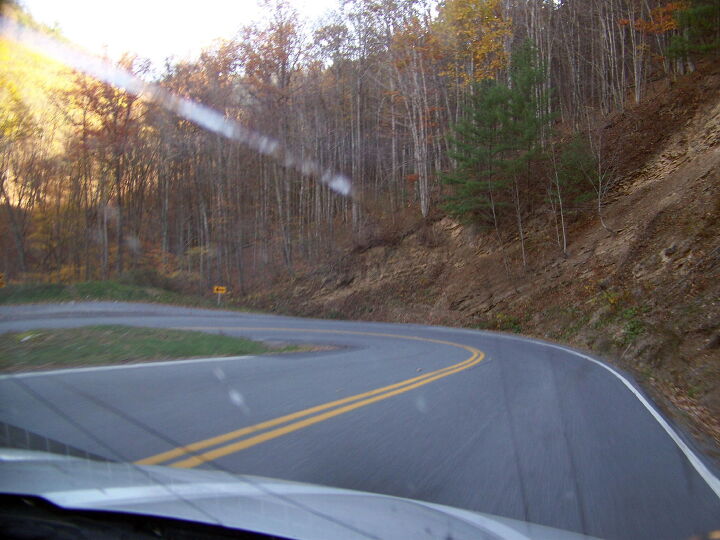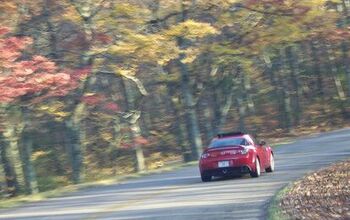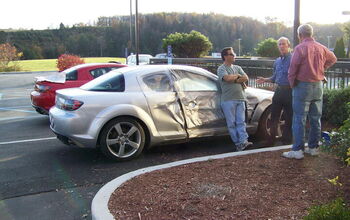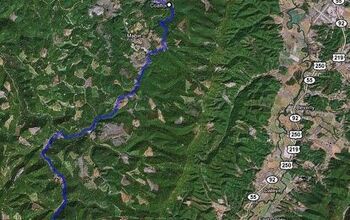A Roadtrip Five Years In The Making: Part 8: Climax
[In this part of my West Virginia road trip five years in the making with my best friend, both of our fathers, and two RX-8s we complete our drive together.]
After lunch I’m compelled to revisit the crash site, dragging the others along. I take the car through the curve, keeping the speed under 40 to avoid any chance of a repeat. What would be more embarrassing than wrecking an already wrecked car? Doing so in the same exact place. At 38 the curve is easily navigated, leading me to wonder how fast my father entered it. In his defense, it’s now much warmer so the tires have more grip.
Thanks to my usual philosophy that we have “plenty of time, “ we’re once again running short of it. I call Cass Scenic Railroad State Park again, and learn that the train doesn’t actually pull out until half an hour after the scheduled time. So we could have easily made it earlier. Need to scoot now. Nevertheless, I decide to take a slightly longer route to check out additional roads. There aren’t many bad ones in the area, and US 250 is better than most, with plenty of tight turns and elevation changes despite its status as a federal highway that cuts a diagonal all the way from Sandusky, Ohio, on Lake Erie to Richmond, Virginia.
Driving through Durbin I spot…a narrow gauge locomotive preparing to run. While there’s just one locomotive, and there’ll be more of them in Cass, I quickly decide that one train at hand is better than two on the other side of the mountain. So we stop.
We decide there’s no point in actually riding the train. We want to see it run, and you don’t really see it run by riding in the cars it’s pushing. You see it run by standing by the side of the track while other people spend $22 a head to ride the train. So we hang around for half an hour as the Durbin Rocket, allegedly one of only three Climax engines still in operation, is prepped. Someone let the fire run low, so the process takes longer than expected. Wood thrown into the firebox to speed things up yields a large amount of very black smoke. The entire area becomes hazy. I pass the minutes studying the mechanicals. Even more than on a conventional steam locomotive, these are a gearhead’s wet dream. (Though I doubt this is the climax they had in mind.)
Where to next? Earlier the judge suggested Goshen Pass, in Virginia. He’s hiked there before. So Goshen it is.
On the way down WV 28 we come across a huge dish poking up above the trees. Turns out that Green Bank, West Virginia, is the location of the National Radio Astronomy Observatory. We stop to check out the “telescope,” apparently the “world’s largest fully steerable single aperture antenna.” There’s only so much time you can spend gazing at a huge dish, so a few minutes later we move on. My father is driving again, and again enjoying every minute of it. Me, I take more photos in the occasional curves, a challenge in itself given the centrifugal forces in play. WV 28 runs through a valley full of farms, and the trees remain colorful, so the scenery is excellent. We fly past a few half-fallen-down barns I wish I could have had another shot at.
Back on 39, we cross into Virginia. Three changes happen. The recommended speeds in the turns get much more conservative—they’re easily 10 MPH below those in West Virginia. One hairpin just across the state line is marked 10. Second, the farms look nicer. Third, more cars are on the road and they are more likely to get in the way.
As 39 crosses small mountain ranges it forms series of switchbacks. Between the ranges it runs straight. So the fun comes in spurts. On one set of switchbacks our progress is severely impeded by a blast from the past: a Mitsubishi 3000GT Spyder VR4—an early hardtop convertible that sold (in very small numbers) for a ridiculous $60,000. Rarely has a 320-horsepower turbocharged DOHC V6 paired with all-wheel-drive been so poorly applied—he’s barely maintaining the recommended speeds through the curves. Certain TTAC contributors would be disgusted.
The two cars swap places after a very brief stop in Goshen—the red RX-8 will now lead the way. Goshen Pass is a bit of a disappointment, at least for me. It’s pretty, but no prettier than many of the other areas we’ve been through. This time of year there’s not much water in the river. But the judge gets a hike, if a short one.
To connect with the Blue Ridge Parkway we head north on 252, then east on 606. VA 252 passes through a beautiful farm-filled valley. On 606 there are no road markings, not even a center line. This suggests that it will be a small, intimate road, but for the first few miles there are many other cars. After Steeles Tavern, though, the other cars fall away, and the road (now VA 56) convolutes as it climbs the Blue Ridge, and my old man has a blast.
The Blue Ridge Parkway travels far above the valleys on either side, affording amazing views. For driving entertainment, though, it’s not quite a match for the other roads we’ve traveled today. The federal government planned it too well. The curves, while plentiful, tend to be sweeping.
We exit the BRP onto I-64, and travel a few miles west to Staunton, where we stop for the night. It’s odd after traveling the back roads to have so many lanes and so many other cars around. We’ve moving a bit too fast, but luck is with us, so a trooper running radar lets us sweep by.
Staunton, though an old, small city, has a vibrant little downtown with a number of interesting restaurants. Of these, I pick the Byers Street Bistro. Once again the four of us get into the red car to drive to the restaurant and back. It turns out to be my favorite of the trip—highly recommended.
The next morning we have breakfast at the hotel. They all say they want to do the same trip next year, just without hitting a tree and with more hiking. Afterwards Trey and the judge head home and my father and I head back into West Virginia.
Michael Karesh operates TrueDelta, an online source of automotive pricing and reliability data
Michael Karesh lives in West Bloomfield, Michigan, with his wife and three children. In 2003 he received a Ph.D. from the University of Chicago. While in Chicago he worked at the National Opinion Research Center, a leader in the field of survey research. For his doctoral thesis, he spent a year-and-a-half inside an automaker studying how and how well it understood consumers when developing new products. While pursuing the degree he taught consumer behavior and product development at Oakland University. Since 1999, he has contributed auto reviews to Epinions, where he is currently one of two people in charge of the autos section. Since earning the degree he has continued to care for his children (school, gymnastics, tae-kwan-do...) and write reviews for Epinions and, more recently, The Truth About Cars while developing TrueDelta, a vehicle reliability and price comparison site.
More by Michael Karesh
Latest Car Reviews
Read moreLatest Product Reviews
Read moreRecent Comments
- Mebgardner I test drove a 2023 2.5 Rav4 last year. I passed on it because it was a very noisy interior, and handled poorly on uneven pavement (filled potholes), which Tucson has many. Very little acoustic padding mean you talk loudly above 55 mph. The forums were also talking about how the roof leaks from not properly sealed roof rack holes, and door windows leaking into the lower door interior. I did not stick around to find out if all that was true. No talk about engine troubles though, this is new info to me.
- Dave Holzman '08 Civic (stick) that I bought used 1/31/12 with 35k on the clock. Now at 159k.It runs as nicely as it did when I bought it. I love the feel of the car. The most expensive replacement was the AC compressor, I think, but something to do with the AC that went at 80k and cost $1300 to replace. It's had more stuff replaced than I expected, but not enough to make me want to ditch a car that I truly enjoy driving.
- ToolGuy Let's review: I am a poor unsuccessful loser. Any car company which introduced an EV which I could afford would earn my contempt. Of course I would buy it, but I wouldn't respect them. 😉
- ToolGuy Correct answer is the one that isn't a Honda.
- 1995 SC Man it isn't even the weekend yet



















































































Comments
Join the conversation
Nice story, makes me want to go drive and enjoy some twists
Enjoying the series Michael. Reminds me of doing a BMW CCA driving school with my father several years ago. Track novices but we enjoyed living out a fantasy and spending time with each other. This is reminding me to do it again before the opportunity passes us by.